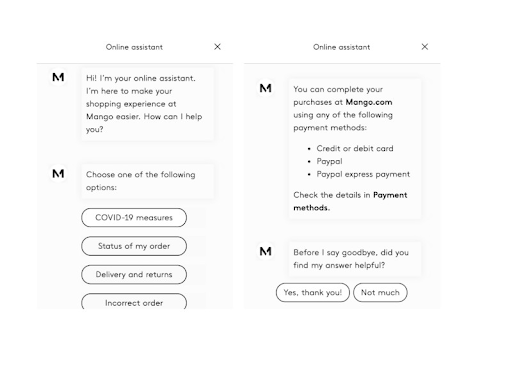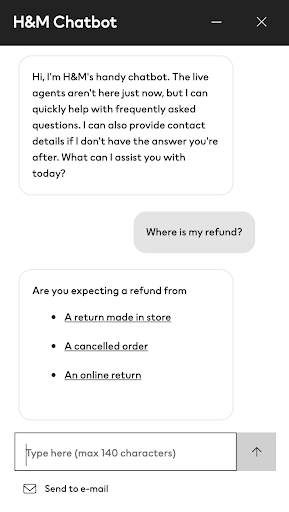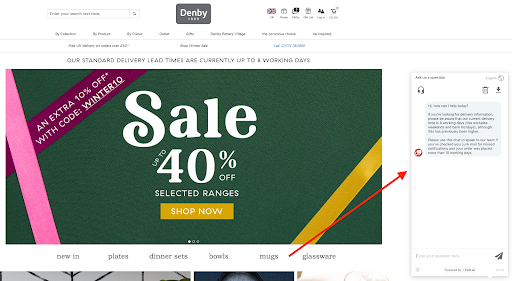As retail continues to move online, a growing number of consumers also expect to communicate with brands online. Retail chatbots present an opportunity to optimise your online customer experience — here’s how.
It’s no secret that today’s consumers love doing their shopping online. According to data from Statista, Internet sales accounted for 28.1% of total retail sales in the UK in September 2021. For context, eCommerce accounted for 13.6% of all retail sales in January 2016.
But not only are consumers shopping online, they also expect customer service to be delivered on online and digital platforms.

Research by HubSpot shows that consumers want to interact with companies through an assortment of 13 digital channels, which include your website and “Contact Us” form, email, Facebook Messenger, Twitter, Slack and live chat.
AI chatbots represent an opportunity to optimise consumer demand for live chat, leveraging artificial intelligence (AI) and natural language processing to automate customer interactions. They’re the perfect solution for beleaguered customer service teams in the retail sector that find themselves struggling to keep up with customer service demand.
What are retail chatbots?
Retail chatbots are computer programs designed to function as a front-of-house customer service team for your business across all your digital channels, whether it’s your website, social media platforms like Facebook and Twitter, or messaging apps like WhatsApp and Telegram. They use AI to understand and respond to your customers’ most commonly asked questions 24 hours a day, 7 days a week — all without any human intervention or control.
More sophisticated AI chatbots for retail applications take this further by enabling core service delivery through chat, letting customers self-serve to perform tasks such as:
- Inquiring about item availability
- Asking about delivery fees
- Purchasing an item
- Tracking their order
- Filing a warranty claim.
When implemented correctly, retail chatbots can serve as always-available, virtual sales associates that guide shoppers through their customer journey. They help solve a common problem in many eCommerce stores: the lack of a mechanism that steers shoppers in the right direction and answers their questions instantly.
These features are unsurprisingly driving massive demand for retail chatbots. According to Insider Intelligence, the global consumer retail spend through AI chatbots is projected to reach $142 billion in 2024 — a tremendous increase from $2.8 billion in 2019.
Retail chatbots: Should you get them?
Fortunately, AI chatbots have never been more accessible, with just about any retail business able to deploy chatbots at scale. At Futr, our no-code retail chatbots are designed to help organisations drive customer satisfaction and sales.
But if you’re still on the fence about chatbots, we’ve put together a brief list of retail chatbot use cases for you to consider.
Retail chatbot use case #1: Virtual shopping assistants
Retail chatbots can be programmed to function as virtual shopping assistants, helping customers find items they may be interested in through prompts such as “What are you looking for?” or “Check out these limited-time offers!”
Virtual shopping assistants are particularly popular in the fashion and beauty/personal care industry. For example, Spanish fashion retailer Mango launched a chatbot on their site in 2020 that signposts visitors to relevant topics such as
- COVID-19 measures
- Order status
- Incorrect orders
- Stores and locations
- Payments
- Plus sizes.

H&M also has a chatbot with very similar features, allowing customers to ask about the status of their order and request a refund, among other things.

Retail chatbot use case #2: Personalised product recommendations
Retail chatbots provide multiple opportunities for brands to develop more streamlined and personalised customer experiences. For starters, AI chatbots can ask shoppers questions to understand their needs.
For example, eBay’s ShopBot functions as an in-store assistant, offering product recommendations to bargain hunters on eBay. This makes it easier for shoppers to make informed purchase decisions sooner than later.
H&M’s Kik chatbot asks customers to answer a brief questionnaire to understand their sense of style. The bot then recommends a series of outfits that match a user’s responses.
Retail chatbot use case #3: Instant responses to customer queries, 24/7
For better or worse, customers expect companies to be available 24 hours a day, 7 days a week. According to a West Unified Communications Services report, 74% of UK consumers report feeling frustrated when customer service is only available during business hours.
Brands like Hotter — a UK-based footwear company — and Denby Pottery — purveyors of handmade tableware and cookware — use chatbots to instantly engage customers. During business hours, the bots signpost to an option to speak with a live agent so complex queries can be resolved quickly.


Retail chatbots are instantly available around the clock. However, they’re not meant to replace your human customer agents; rather, they take care of simple and repetitive questions and allow your live agents to focus on more complex queries.
Aside from round-the-clock immediacy in responses, this also creates a positive experience for customers. At the height of the COVID-19 pandemic, Lidl in Ireland used a WhatsApp chatbot to help customers avoid queues and find the quietest times of the day to shop and maintain social distancing. Customers simply had to send a message to let the chatbot know what time of the day they plan to visit, allowing the chatbot to aggregate responses and provide recommendations on when to visit.
Retail chatbot use case #4: Cart recovery through chat
According to the Baymard Institute, roughly 69.82% of online shopping carts end up being abandoned. In other words, for every 100 customers that add items to their cart on your site, around 70 leave and never complete the purchase.
However, some of these potential customers are already interested in your brand and simply need a push to make a final purchase decision — a process known as cart recovery.
Traditionally, cart recovery strategies are driven by follow-up emails, which can recoup up to 14% of lost sales. But we believe chatbots offer a more engaging alternative, sending reminders to undecided shoppers to hit the checkout button. These messages can be sent through the digital platforms they’re already active in, whether it’s WhatsApp or Facebook Messenger.
Integrate conversational AI into your customer communications with retail chatbots
As chatbots hit the mainstream in 2022 and beyond, more retail businesses will eventually understand the benefits of rolling out bots across their digital channels. Whether you run a large online store selling fast-moving consumer goods or a boutique fashion store, chatbots allow you to stay on top of customer queries at all times and guide shoppers through their journey — all without having to increase your staff count.
Follow the Futr blog to get more insights on how our AI chatbots for the retail industry can transform the retail experience for your customers. Get in touch with the Futr team to schedule a FREE demo of our live chat and chatbot platform for your eCommerce store.

